Analys
Not below USD 70/b and aiming for USD 80/b

Saudi Arabia again reminded the global oil market who is king. Oil price is ticking carefully upwards today as investors are cautious after having burned their fingers in the production cut induced rally to (almost) USD 90/b which later faltered. We expect more upside price action later today in the US session. The 1 m b/d Saudi cut in July is a good tactic for the OPEC+ meeting on 4-6 July. Unwind if not needed or force all of OPEC+ to formal cut or else….Saudi could unwind in August. The cut will unite Saudi/Russia and open for joint cuts if needed. I.e. it could move Russia from involuntary reductions to deliberate reductions

Adjusting base-lines and formalizing and extending May cuts to end of 2024. OPEC+ this weekend decided to extend and formalize the voluntary agreement of cuts in May. These cuts will now be and overall obligation for the group to produce 40.5 m b/d on average in 2024 (not including natural gas liquids). There were some adjustments to reference production levels where African members got lower references as they have been unable to fill their quotas. UAE on the other hand got a 200 k b/d increase in its reference production level to match actual capacity increases. It was also a discussion of whether to change the baseline for Russia’s production. But these changes in baselines won’t make any immediate changes to production.
Unilateral cut of 1 m b/d by Saudi in July. The big surprise to the market was the unilateral 1 m b/d cut of Saudi Arabia for July. To start with it is for July only though it could be extended. The additional cut will
1) Make sure the oil price won’t fall below 70
2) Prevent inventories from rising
3) Help prevent capex spending in upstream oil and gas globally is not getting yet another trough
4) Make for a great tactical negotiation setup for next OPEC+ meeting on 4-6 July
a) If the 1 m b/d July cut is unnecessary, then it will be un-winded for August
b) If it indeed was needed then Saudi can strong-arm rest of OPEC+ to make a combined cut from August. Else Saudi could revive production by 1 m b/d from August and price will fall.
5) It is roughly aligning actual production by Russia and Saudi Arabia. Actually it is placing Saudi production below Russian production. But basically it is again placing the two core OPEC+ members on equal footing. Thus opening the door for combined Saudi/Russia cuts going forward if needed.
Saudi produced / will produce /Normal production:
April: 10.5
May: 10.0
June: 10.0
July: 9.0
Normal prod: 10.1
Oil price to strengthen further. Especially into the US session today. We expect crude oil prices to strengthen further and especially into the US session today. Price action has been quite careful in response to the surprise 1 m b/d cut by Saudi Arabia so far today. Maybe it is because it is only for one month. But mostly it is probably because the market in recent memory experienced that the surprise cut for May sent the Dated Brent oil price to USD 88.6/b in mid-April before it again trailed down to almost USD 70/b. So those who joined the rally last time got burned. They are much more careful this time around.
USD 80/b is the new USD 60/b and that is probably what Saudi Arabia is aiming for. Not just because that is what Saudi Arabia needs but also because that is what the market needs. We have seen a sharp decline in US oil rig count since early December last year and that has taken place at an average WTI price of USD 76/b and Brent average of USD 81/b. Previously the US oil rig count used to expand strongly with oil prices north of USD 45/b. Now instead it is declining at prices of USD 75-80/b. Big difference. Another aspect is of course inflation. US M2 has expanded by 35% since Dec 2019 and so far US CPI has increased by 17% since Dec 2019. Assume that it will rise altogether by 30% before all the stimulus money has been digested. If the old oil price normal was USD 60/b then the new should be closer to USD 80/b if adjusting for a cumulative inflation increase of 30%. But even if we just look at nominal average prices we still have USD 80/b as a nominal average from 2007-2019. But that is of course partially playing with numbers.
Still lots of concerns for a global recession, weakening oil demand and lower oil prices due to the extremely large and sharp rate hikes over the past year. That is the reason for bearish speculators. But OPEC+ has the upper hand. This is what we wrote recently on that note: ”A recession is no match for OPEC+”
Aligning Saudi production with Russia. Russian production has suffered due to sanctions. With a 1 m b/d cut in July Saudi will be below Russia for the first time since late 2021. Russia and Saudi will again be equal partners. This opens up for common agreements of cuts. Reduced production by Russia since the invasion has been involuntary. Going forward Russia could make deliberate cuts together with Saudi.
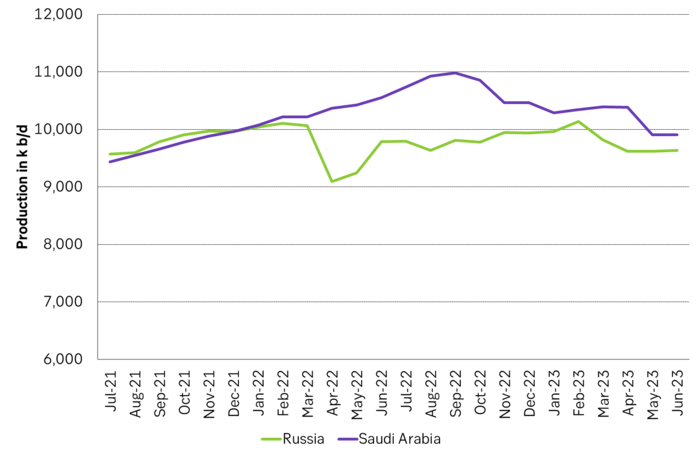
Short specs in Brent and WTI at 205 m barrels as of Tuesday last week. They will likely exit shorts and force the oil price higher.
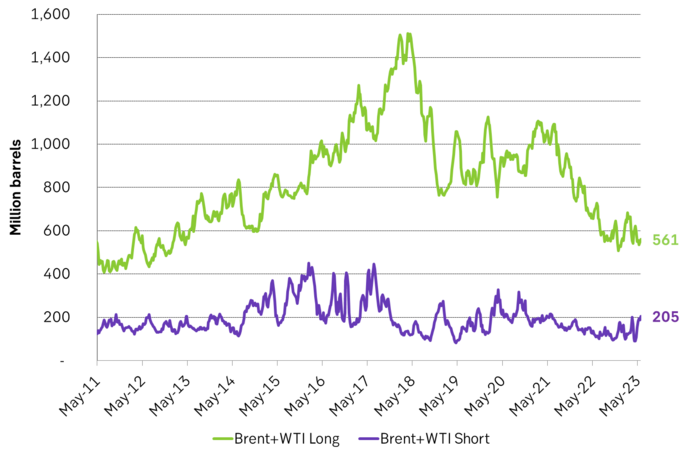
Long vs. Short specs in Brent and WTI at very low level as of Tuesday last week. Will probably bounce back up.
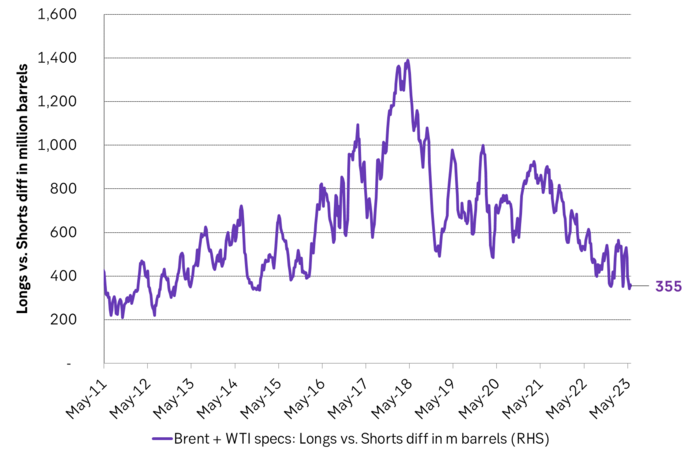
US oil rig count has declined significantly since early Dec-2022 at WTI prices of USD 76/b and Brent of USD 81/b (average since Dec-2022).
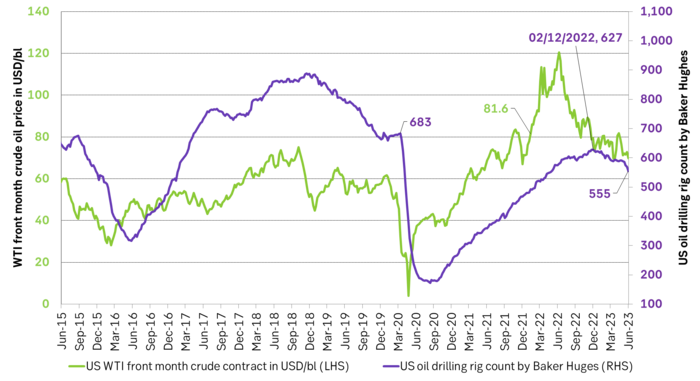
Historical oil prices in nominal and CPI adjusted terms. Recent market memory is USD 57.5/b average from 2015-2019. But that was an extremely bearish period with booming US shale oil production.
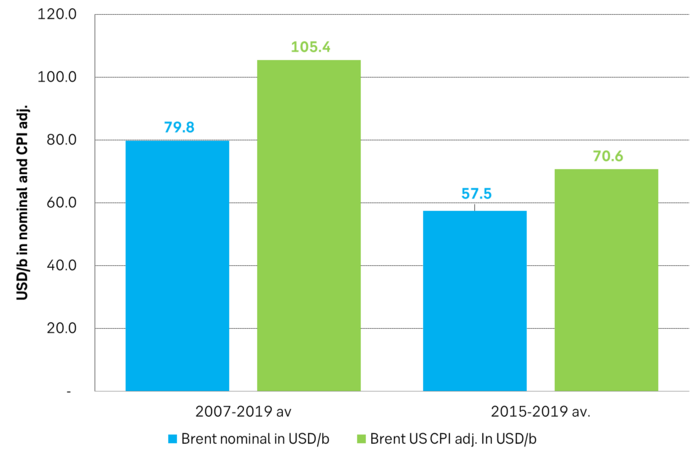
Analys
Tightening fundamentals – bullish inventories from DOE

The latest weekly report from the US DOE showed a substantial drawdown across key petroleum categories, adding more upside potential to the fundamental picture.

Commercial crude inventories (excl. SPR) fell by 5.8 million barrels, bringing total inventories down to 415.1 million barrels. Now sitting 11% below the five-year seasonal norm and placed in the lowest 2015-2022 range (see picture below).
Product inventories also tightened further last week. Gasoline inventories declined by 2.1 million barrels, with reductions seen in both finished gasoline and blending components. Current gasoline levels are about 3% below the five-year average for this time of year.
Among products, the most notable move came in diesel, where inventories dropped by almost 4.1 million barrels, deepening the deficit to around 20% below seasonal norms – continuing to underscore the persistent supply tightness in diesel markets.
The only area of inventory growth was in propane/propylene, which posted a significant 5.1-million-barrel build and now stands 9% above the five-year average.
Total commercial petroleum inventories (crude plus refined products) declined by 4.2 million barrels on the week, reinforcing the overall tightening of US crude and products.


Analys
Bombs to ”ceasefire” in hours – Brent below $70

A classic case of “buy the rumor, sell the news” played out in oil markets, as Brent crude has dropped sharply – down nearly USD 10 per barrel since yesterday evening – following Iran’s retaliatory strike on a U.S. air base in Qatar. The immediate reaction was: “That was it?” The strike followed a carefully calibrated, non-escalatory playbook, avoiding direct threats to energy infrastructure or disruption of shipping through the Strait of Hormuz – thus calming worst-case fears.

After Monday morning’s sharp spike to USD 81.4 per barrel, triggered by the U.S. bombing of Iranian nuclear facilities, oil prices drifted sideways in anticipation of a potential Iranian response. That response came with advance warning and caused limited physical damage. Early this morning, both the U.S. President and Iranian state media announced a ceasefire, effectively placing a lid on the immediate conflict risk – at least for now.
As a result, Brent crude has now fallen by a total of USD 12 from Monday’s peak, currently trading around USD 69 per barrel.
Looking beyond geopolitics, the market will now shift its focus to the upcoming OPEC+ meeting in early July. Saudi Arabia’s decision to increase output earlier this year – despite falling prices – has drawn renewed attention considering recent developments. Some suggest this was a response to U.S. pressure to offset potential Iranian supply losses.
However, consensus is that the move was driven more by internal OPEC+ dynamics. After years of curbing production to support prices, Riyadh had grown frustrated with quota-busting by several members (notably Kazakhstan). With Saudi Arabia cutting up to 2 million barrels per day – roughly 2% of global supply – returns were diminishing, and the risk of losing market share was rising. The production increase is widely seen as an effort to reassert leadership and restore discipline within the group.
That said, the FT recently stated that, the Saudis remain wary of past missteps. In 2018, Riyadh ramped up output at Trump’s request ahead of Iran sanctions, only to see prices collapse when the U.S. granted broad waivers – triggering oversupply. Officials have reportedly made it clear they don’t intend to repeat that mistake.
The recent visit by President Trump to Saudi Arabia, which included agreements on AI, defense, and nuclear cooperation, suggests a broader strategic alignment. This has fueled speculation about a quiet “pump-for-politics” deal behind recent production moves.
Looking ahead, oil prices have now retraced the entire rally sparked by the June 13 Israel–Iran escalation. This retreat provides more political and policy space for both the U.S. and Saudi Arabia. Specifically, it makes it easier for Riyadh to scale back its three recent production hikes of 411,000 barrels each, potentially returning to more moderate increases of 137,000 barrels for August and September.
In short: with no major loss of Iranian supply to the market, OPEC+ – led by Saudi Arabia – no longer needs to compensate for a disruption that hasn’t materialized, especially not to please the U.S. at the cost of its own market strategy. As the Saudis themselves have signaled, they are unlikely to repeat previous mistakes.
Conclusion: With Brent now in the high USD 60s, buying oil looks fundamentally justified. The geopolitical premium has deflated, but tensions between Israel and Iran remain unresolved – and the risk of missteps and renewed escalation still lingers. In fact, even this morning, reports have emerged of renewed missile fire despite the declared “truce.” The path forward may be calmer – but it is far from stable.
Analys
A muted price reaction. Market looks relaxed, but it is still on edge waiting for what Iran will do

Brent crossed the 80-line this morning but quickly fell back assigning limited probability for Iran choosing to close the Strait of Hormuz. Brent traded in a range of USD 70.56 – 79.04/b last week as the market fluctuated between ”Iran wants a deal” and ”US is about to attack Iran”. At the end of the week though, Donald Trump managed to convince markets (and probably also Iran) that he would make a decision within two weeks. I.e. no imminent attack. Previously when when he has talked about ”making a decision within two weeks” he has often ended up doing nothing in the end. The oil market relaxed as a result and the week ended at USD 77.01/b which is just USD 6/b above the year to date average of USD 71/b.

Brent jumped to USD 81.4/b this morning, the highest since mid-January, but then quickly fell back to a current price of USD 78.2/b which is only up 1.5% versus the close on Friday. As such the market is pricing a fairly low probability that Iran will actually close the Strait of Hormuz. Probably because it will hurt Iranian oil exports as well as the global oil market.
It was however all smoke and mirrors. Deception. The US attacked Iran on Saturday. The attack involved 125 warplanes, submarines and surface warships and 14 bunker buster bombs were dropped on Iranian nuclear sites including Fordow, Natanz and Isfahan. In response the Iranian Parliament voted in support of closing the Strait of Hormuz where some 17 mb of crude and products is transported to the global market every day plus significant volumes of LNG. This is however merely an advise to the Supreme leader Ayatollah Ali Khamenei and the Supreme National Security Council which sits with the final and actual decision.
No supply of oil is lost yet. It is about the risk of Iran closing the Strait of Hormuz or not. So far not a single drop of oil supply has been lost to the global market. The price at the moment is all about the assessed risk of loss of supply. Will Iran choose to choke of the Strait of Hormuz or not? That is the big question. It would be painful for US consumers, for Donald Trump’s voter base, for the global economy but also for Iran and its population which relies on oil exports and income from selling oil out of that Strait as well. As such it is not a no-brainer choice for Iran to close the Strait for oil exports. And looking at the il price this morning it is clear that the oil market doesn’t assign a very high probability of it happening. It is however probably well within the capability of Iran to close the Strait off with rockets, mines, air-drones and possibly sea-drones. Just look at how Ukraine has been able to control and damage the Russian Black Sea fleet.
What to do about the highly enriched uranium which has gone missing? While the US and Israel can celebrate their destruction of Iranian nuclear facilities they are also scratching their heads over what to do with the lost Iranian nuclear material. Iran had 408 kg of highly enriched uranium (IAEA). Almost weapons grade. Enough for some 10 nuclear warheads. It seems to have been transported out of Fordow before the attack this weekend.
The market is still on edge. USD 80-something/b seems sensible while we wait. The oil market reaction to this weekend’s events is very muted so far. The market is still on edge awaiting what Iran will do. Because Iran will do something. But what and when? An oil price of 80-something seems like a sensible level until something do happen.
-

 Nyheter4 veckor sedan
Nyheter4 veckor sedanUppgången i oljepriset planade ut under helgen
-

 Nyheter3 veckor sedan
Nyheter3 veckor sedanMahvie Minerals växlar spår – satsar fullt ut på guld
-

 Nyheter4 veckor sedan
Nyheter4 veckor sedanLåga elpriser i sommar – men mellersta Sverige får en ökning
-

 Nyheter2 veckor sedan
Nyheter2 veckor sedanOljan, guldet och marknadens oroande tystnad
-

 Analys4 veckor sedan
Analys4 veckor sedanVery relaxed at USD 75/b. Risk barometer will likely fluctuate to higher levels with Brent into the 80ies or higher coming 2-3 weeks
-

 Nyheter2 veckor sedan
Nyheter2 veckor sedanJonas Lindvall är tillbaka med ett nytt oljebolag, Perthro, som ska börsnoteras
-

 Analys3 veckor sedan
Analys3 veckor sedanA muted price reaction. Market looks relaxed, but it is still on edge waiting for what Iran will do
-

 Nyheter2 veckor sedan
Nyheter2 veckor sedanDomstolen ger klartecken till Lappland Guldprospektering











